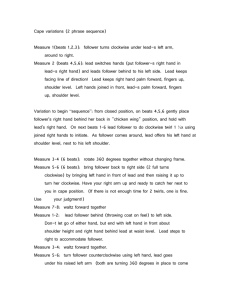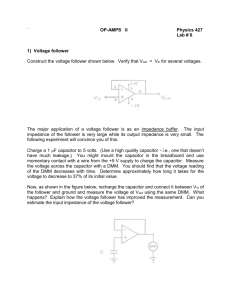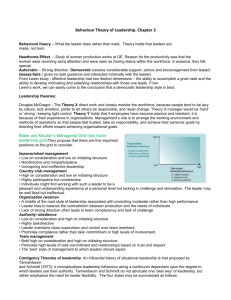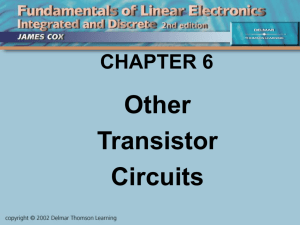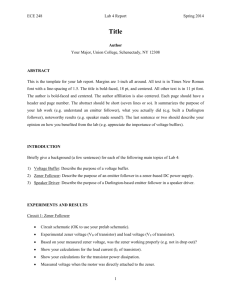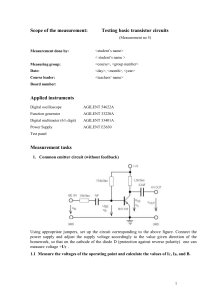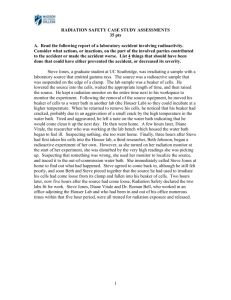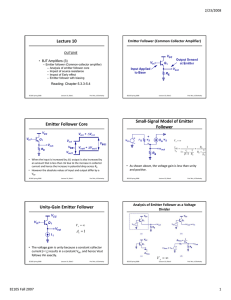E5-12 - Stanford University
advertisement
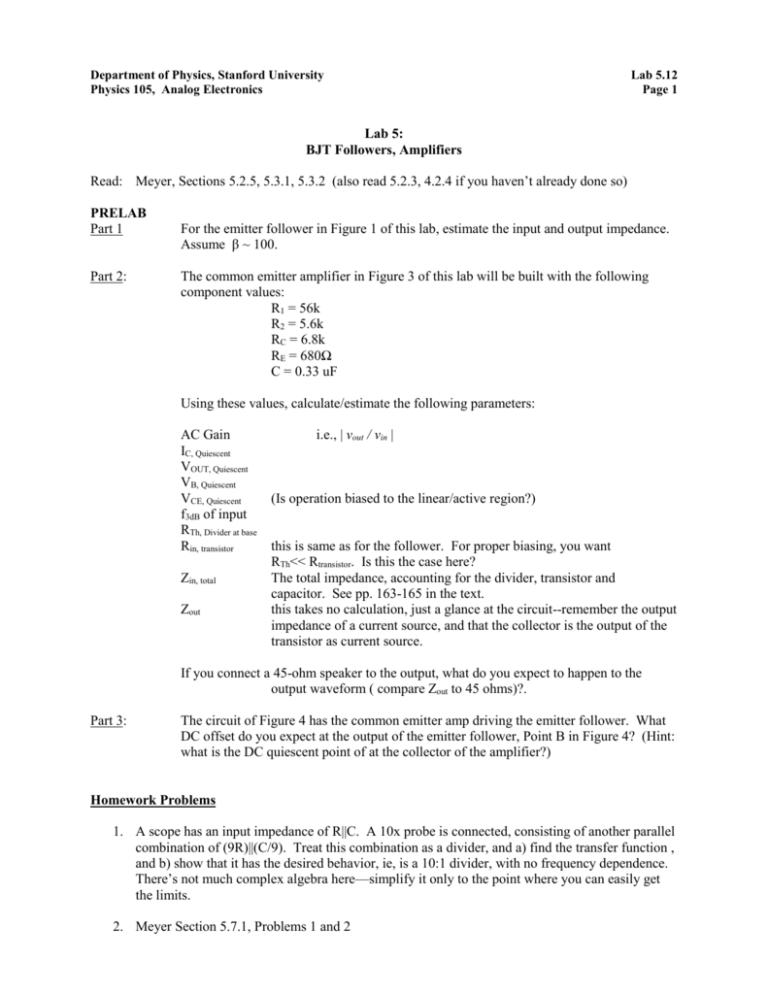
Department of Physics, Stanford University Physics 105, Analog Electronics Lab 5.12 Page 1 Lab 5: BJT Followers, Amplifiers Read: Meyer, Sections 5.2.5, 5.3.1, 5.3.2 (also read 5.2.3, 4.2.4 if you haven’t already done so) PRELAB Part 1 Part 2: For the emitter follower in Figure 1 of this lab, estimate the input and output impedance. Assume β ~ 100. The common emitter amplifier in Figure 3 of this lab will be built with the following component values: R1 = 56k R2 = 5.6k RC = 6.8k RE = 680Ω C = 0.33 uF Using these values, calculate/estimate the following parameters: AC Gain IC, Quiescent VOUT, Quiescent VB, Quiescent VCE, Quiescent f3dB of input RTh, Divider at base Rin, transistor Zin, total Zout i.e., | vout / vin | (Is operation biased to the linear/active region?) this is same as for the follower. For proper biasing, you want RTh<< Rtransistor. Is this the case here? The total impedance, accounting for the divider, transistor and capacitor. See pp. 163-165 in the text. this takes no calculation, just a glance at the circuit--remember the output impedance of a current source, and that the collector is the output of the transistor as current source. If you connect a 45-ohm speaker to the output, what do you expect to happen to the output waveform ( compare Zout to 45 ohms)?. Part 3: The circuit of Figure 4 has the common emitter amp driving the emitter follower. What DC offset do you expect at the output of the emitter follower, Point B in Figure 4? (Hint: what is the DC quiescent point of at the collector of the amplifier?) Homework Problems 1. A scope has an input impedance of R||C. A 10x probe is connected, consisting of another parallel combination of (9R)||(C/9). Treat this combination as a divider, and a) find the transfer function , and b) show that it has the desired behavior, ie, is a 10:1 divider, with no frequency dependence. There’s not much complex algebra here—simplify it only to the point where you can easily get the limits. 2. Meyer Section 5.7.1, Problems 1 and 2 Department of Physics, Stanford University Physics 105, Analog Electronics Lab 5.12 Page 2 LAB Day 1: Part 1 Day 2: Parts 2,3,4 1. 2. 3. 4. 5. Lab tips for this week: This week you will start using a powered breadboard--with DC power terminals. Do not apply external power to these terminals--you will blow the internal power supply, and will be rewarded with the opportunity to learn how to repair it—it’s not that hard. Rotate your breadboard 90° counterclockwise so the power terminals are on the left. Use the horizontal rows of holes as your power “rails”. The circuits this week can be noisy, so there is a premium on learning to wire things neatly, with resistors and wires close to the board, rails on separated bus strips, etc. Remember, make the layout look like the schematic. Use your needle nose pliers (see your lab drawer) to help get wires in and out of the board neatly. ScopesmanshipI: Use a 10x probe to look at all output waveforms on the scope. The only time not to use one is for the function generator output. ScopesmanshipII: you will need to use either/or both of the following to see all of the effects in this lab: .-- AC coupling to measure AC gains (amplification) .-- DC coupling to see offset effects from followers. Part 1. Emitter Follower: (repeated from Lab 4) (25 pts) Build this circuit in the upper right hand corner of your breadboard. Save the circuit – you will use it again in Part 3 of the lab. Vcc (+15V) 270 In 2N3904 a. Drive the circuit in Figure 1with a 1kHz, 1V peak (2Vpp) sine wave. Use a 10x scope probe to look at the output on the scope. Submit the input and output waveforms on one plot. Show the 0.6V drop on the positive half of the cycle. Out 3.3k Vee b. Explain why the output is not a replica of the input. Figure 1 c. Increase the amplitude until you see bumps below ground. Explain; be quantitative. (Hint: the VBE reverse breakdown spec for this transistor is 6V). d. Return to 1V input. Connect the lower part of the emitter resistor (labeled Vee) to-15V. Submit the input and output waveforms again. e. Explain the improvement. f. Replace the 270 ohm resistor with a 10k; this will give you a high impedance source. See Figure 2. Use a 1V peak input and measure the output impedance of this follower circuit. Do this by measuring the output voltage with and without the 1k “load” connected, then use the voltage divider concept. (this won’t be precise, but you should conclude that Zout is low). Show your circuit and explain how you used your measurements to arrive at Zout +15V In 10k Out 2N3904 3.3k 1k Load -15V Figure 2 Department of Physics, Stanford University Physics 105, Analog Electronics Lab 5.12 Page 3 g. Remove the 1k load, then use a 10V peak signal to measure the input impedance of the follower by measuring the signal on both sides of the 10k resistor (there is nothing connected to the output for this measurement, not even the scope). Show your circuit and explain how you used your measurements to arrive at Zin . Remember to save your circuit from Part 1 for Part 3 of the lab. Vcc (+15V) Part 2: Common Emitter Amplifier: (25 pts) Build this circuit on your breadboard to the left of the Emitter Follower from Part 1—you will eventually connect the two. Where not specified, use a 100mv peak input (200mVpp, pp≡peak-topeak), and 1kHz. R1 Out In Build the amplifier in Figure 3 to the left of the emitter follower on your breadboard (you will connect them later). Use these component values: R1 = 56k R2 = 5.6k RC = 6.8k RE = 680Ω C = 0.33 uF [For questions 1-4 below, provide your prelab calculations for comparison to measurement] C 2N3904 R2 Re Vee Figure 3 1. With no AC input (function generator disconnected), measure all DC quiescent voltages. Compare with prelab prediction. 2. Connect the function generator. show a plot of input and output waveforms at 1 kHz, and measure amplifier AC gain and phase shift at this point. Compare with predicted. 3. measure 3dB frequency of the amplifier – measured from input to output with NO LOAD. Compare with predicted. 4. measure Zout @ 1kHz. Specify an appropriate resistive load for this measurement. Compare with predicted. 5. Attach a 45 ohm speaker to the output. Show waveform (or, at least what’s left of it) . Pay attention to the speaker volume — this will improve in Part 3 below. Keep your circuit built on your breadboard to use in Part 3. Rc Department of Physics, Stanford University Physics 105, Analog Electronics Part 3: Emitter Follower Buffer (15 pts) In this part of the lab you will demonstrate the benefit of a follower. Connect the output of your amplifier (remove the speaker) to the input of the emitter follower from Part 1. See point A in Figure 4. Keep your input to 100 mV peak as before. 1. Apply an AC input to the amplifier—no speaker—and look at the output of the follower (Point B in Figure 4). Submit the input and output waveforms. Lab 5.12 Page 4 Vcc (+15V) R1 In Rc 270 A C 2N3904 R2 2N3904 3.3k Re Vee Vee Figure 4 2. Now connect the speaker to the output, Point B in Figure 4. Compare with Part 2 the difference both in speaker volume (for the same input) and overall AC gain (measure signal voltage delivered to the speaker). 3. Explain this improvement quantitatively in terms of impedances: Zout of amp, Zin and Zout of follower. Specifically, show the Thevenin equivalent circuits, and voltage divider calculations, of a. the amplifier driving the follower, b. the follower driving the speaker. Out B



